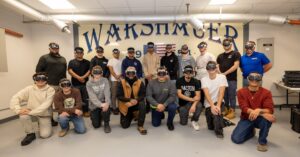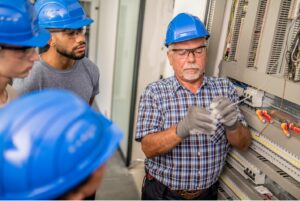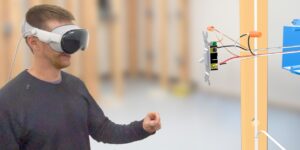Training and reskilling are two areas that have been completely revolutionized by digital technology. Extending beyond the analog world, 3D work instructions and digital learning platforms now empower field technicians to efficiently build the skill sets needed to succeed.
Today’s multisensory, interactive training approaches cater to a busy workforce that needs more than the basics. Companies that adapt to this need deliver more efficient training systems, improve field tech performance, and ultimately create stronger products with next-generation data analytics.
Using the right digital technology also creates a more desirable work environment. Today’s workers expect excellent training opportunities from their company. Organizations that offer superior training options can expect better employee retention and an elevated ability to attract new talent. While digital transformation can be intimidating, interactive 3D work instructions provide one of the easiest ways for any company to take a major leap forward.

Using 3D Work Instructions to Embrace Personalization and Mobility
Personalization and flexibility are critical pillars of modernized training. To encourage field service techs to fully grasp essential skills, team leaders need a customizable approach that takes advantage of today’s best technology.
Creating a personalized learning path that caters to a technician’s strengths and specific needs can shorten training time and provide better results. With personalized learning now prevalent, it’s no surprise that more than 80% of employees want on-demand training that lets them pick up learning materials anytime, anywhere.
However, team managers can be limited by manufacturers that use older instructional models. Paper instructions provide a narrow, single point of view and restrict customization during training.
Lacking the versatile, interactive elements of 3D work instructions, paper models can slow progress by providing only one path to learning the material. This is especially problematic for younger field techs, who typically have higher expectations for a company’s tech infrastructure.
Leading 3D instructional models offer a multifaceted learning approach while adjusting for a field tech’s busy schedule. With easy offloading, 3D instructions let technicians learn from anywhere, helping them get up to speed much faster than with traditional materials. The enhanced mobility is particularly effective with veteran technicians who are upskilling and/or learning new models. Even long-time technicians who are accustomed to paper-based training are usually won over by the fluidity of modernized training approaches.
Interactive Elements Mean More Efficient Learning
The digital age is just now moving into maturity, with features like immersive simulations starting to take off. For field technicians, the expanded digital world should be a boon to efficiency. Modern field tech training programs can provide a hands-on experience built to empower trainees to see a product from every angle. Manufacturers and company leaders should take advantage of this new era in training capabilities and focus on implementing easy-to-use technology that allows for ongoing learning that extends beyond a basic training program.
Related: How to Upskill Your Technicians for Today’s Field Service Landscape
Interactive 3D digital imagery is one of the best ways for companies to increase engagement and understanding as new hires develop essential skills. Being able to zoom and rotate digital images to any angle helps trainees find the perspective that will let them fully visualize the installation. This ability is also instrumental in improving the performance of technicians in the field. Visuals that can be manipulated with a touch are easy and intuitive for any trainee to use.
A robust suite of interactive elements also provides a level of hands-on experience techs can benefit from before they even go out into the field. 3D digital technology can deliver insights that formerly were only possible with direct work experience. With a modern toolkit, newly trained employees head out with a much better understanding of equipment and products, increasing their chances of success.
Some key interactive elements to focus on include:
- Multisensory learning opportunities. Workers simply do better when they have multiple ways to learn. Digital platforms that use 360° views and re-playable animations create a more effective learning foundation.
- Effortless searches. One of the easiest ways to frustrate a field tech is to make information difficult to locate. Searching digital instructions instantly connects technicians with the information they need.
- Intuitive digital tools that let trainees quickly make progress. The best training programs are forward learning without being overly complicated. The last thing manufacturers need to create is a technological barrier that trainees will struggle with. Digital tools should be intuitive, easy to master, and designed to quickly get field techs up to speed.
Robust Upskilling Options Help Techs Grow
Excellent training for new techs is mandatory, but companies can easily overlook the importance of refreshing and upskilling veteran employees. A Gallup study found that 57% of employees want to grow and improve their skill set—and they’re willing to leave for other jobs that provide better retraining. Given the expense of replacing a skilled field tech, today’s companies must have modernized learning opportunities to minimize turnover and elevate performance.
Having excellent training programs backed by superior instruction is also essential for attracting new talent. Within a competitive labor market, companies that appear behind in upskilling have a harder time attracting able employees from tomorrow’s workforce. The 18–24 demographic, for example, strongly considers upskilling when looking at positions. While digital 3D work instructions cater to the desire to continually learn on the job in hands-on, visual ways, traditional systems struggle to keep pace with worker expectations.
Fast Product Updates Ensure Accuracy
Field technicians can only effectively achieve the accuracy of the information they use. Unannounced changes or errors in instruction require on-the-job trial and error to solve. Techs need to know they’re working with the most up-to-date information possible to proceed with confidence.
Manufacturers must be nimble when making alterations to products or models. Without a system in place that allows for quick updating, they risk creating confusion and frustration among new hires and veteran techs alike.
For companies that rely on paper models, the updating process can be painstaking, inefficient, and costly. Reprinting and redistributing product updates can delay training and dent budgets all while presenting antiquated instruction visuals to field techs. Video-based instructions can be easier to update than paper models but might require costly reshoots or substantial edits. Manufacturers can ditch reprinting costs, streamline processes, and even further ESG goals with the right digital technology.
With today’s top digital training tools, companies have much more control. When a product is updated or instructions are amended, a modernized training system lets companies quickly disseminate information and maintain accuracy.
Backed by cloud functionality and real-time updating capability, technicians can have confidence that their 3D work instructions are up to date every time they’re in the field. Manufacturers, meanwhile, know they can efficiently update their instructions and ensure effective training.
An Ecosystem of Improvement
Quick and seamless updates are an important part of a modern training program, but thriving digital systems also create feedback loops that link manufacturers, installers, and end users. Manufacturers want to know how effective their instructions are for training and upskilling. Paper and video-based models don’t create channels for user feedback. Meanwhile, digitally-based platforms can automatically collect user analytics that R&D teams can use for the ongoing improvement of products.
A feedback loop based on modern data analytics helps in a variety of areas. Manufacturers gain valuable insight into the end process and can see how well field techs are able to follow instructions. For field techs who will be completing (or resolving) installations for end users, user analytics helps pinpoint issues and create a superior troubleshooting process. Strong feedback loops translate to more precise training, more efficient installations, and fewer callbacks.
Systems that Can Handle Diverse Groups of Workers
About 10 percent of American workers have restricted proficiency in English, with the workforce continuing to diversify. This is a big problem for companies that use training programs and materials that primarily rely on text content and only incorporate one or two languages. Unfortunately, many talented field technicians struggle in training when they don’t get to use their native language. This can undercut the potential of many employees and stunt the growth of training programs.
It’s also a problem that can be easily resolved with next-generation digital technology. Having fully interactive visual components bridges language gaps and ensures that all trainees have the tools to succeed.
Related: 5 Ways Cutting Edge 3D Digital Work Instruction Software Improves Field Service Work
While it’s an additional challenge to be inclusive with paper instructions and traditional training materials, digital systems allow for easier translations that let trainees learn in their native language. Many companies have policies about being more inclusive, but using analog systems can undercut inclusivity strategies. A powerful digital toolkit creates more effective training programs that benefit workers from all backgrounds.
An Easy Way to Step Into the Digital Age
Fully modernizing a company’s processes is an enormous task that can feel daunting, especially when it comes to training in a challenging labor environment. Starting with the easiest, most practical steps can help companies efficiently begin the process in a worker-friendly way. Manufacturers who convert PDFs or older CAD to immersive 3D work instructions take a leap forward in digital transformation without disrupting the business.
Seamless integration is only one of the benefits of converting outdated instructions. Unlike more complicated and time-intensive transformations (like digital record keeping), switching to 3D instructions is a faster upgrade that lets teams quickly experience the upside. As companies deal with headaches in other parts of digitalization, implementing 3D instructions is a relatively easy process that directly bolsters performance by empowering field techs.
Stay Ahead with Superior Field Tech Training
Training and effective, ongoing instruction have always been important, but today’s workforce expects more than the basics. Creating a robust, continuous training system is the key to employee retention, maximizing the potential of field techs and attracting the next generation of talent. Implementing a high-powered, digitally based training system that creates ongoing learning opportunities can make a fundamental difference in your training program. BILT’s interactive 3D work instructions provide a superior way to reach the next generation of workers while also letting veteran employees upskill at their own pace. Our platform is designed to make product learning effortless, helping companies hone skill sets and deliver more capable teams of field technicians. Get in touch with our team for more on what BILT’s app can do to enhance field tech performance.



